The world outside our windows is teeming with avian personalities, each with their unique traits, behaviors, and quirks. Backyard bird watching offers a fascinating glimpse into the rich tapestry of bird life that surrounds us every day. Beyond simply identifying species, recognizing the distinct personalities of your feathered visitors can transform a casual hobby into a meaningful connection with nature. From bossy blue jays to methodical woodpeckers, understanding the character traits of common backyard birds adds a new dimension to your observation skills and deepens your appreciation for these remarkable creatures. This guide will help you recognize and appreciate the diverse personalities of the birds that grace your outdoor space daily.
The Territorial Cardinals: Bright Red Sentinels

Northern Cardinals are among the most recognizable and beloved backyard visitors, with males sporting brilliant red plumage that stands out against any backdrop. These birds exhibit distinctly territorial personalities, especially during breeding season when males can be observed defending their space with remarkable vigilance. You might notice a male cardinal repeatedly attacking his reflection in windows or car mirrors, believing he’s confronting a rival. This territorial behavior extends to their distinctive singing patterns, with males often perching at the highest points in your yard to announce their presence and claim their domain. Despite their territorial nature, cardinals form strong pair bonds and can frequently be spotted feeding together, with males often passing seeds to females in a charming courtship ritual.
The Bullying Blue Jays: Intelligent Opportunists
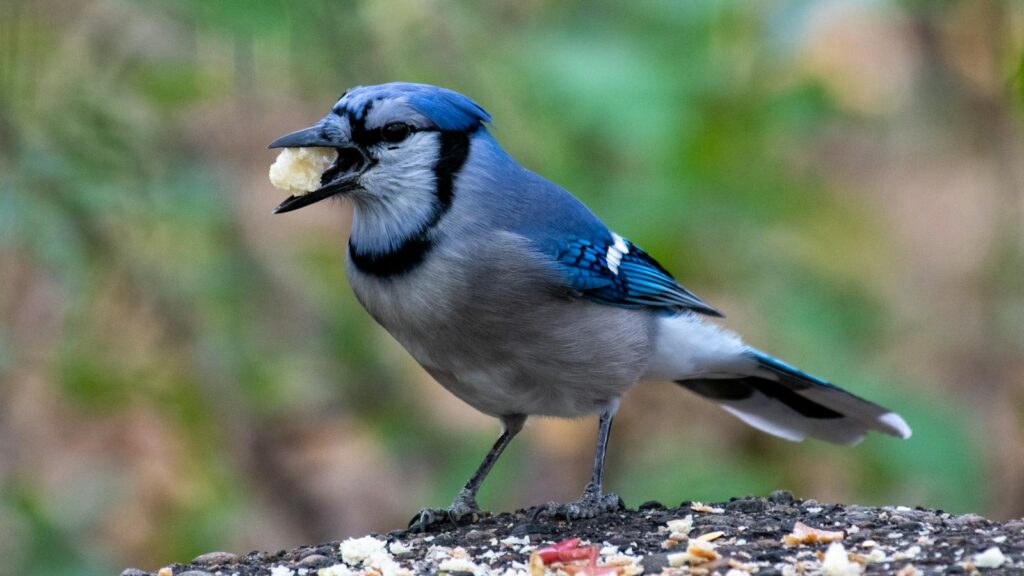
Blue Jays bring both beauty and drama to your backyard with their striking blue plumage and loud, assertive personalities. These intelligent corvids are often characterized as the “bullies” of bird feeders, swooping in with loud calls that scatter smaller birds. Their bold, opportunistic nature is evident as they strategically time their feeder visits, often waiting until smaller birds have discovered food before making their dramatic entrance. Blue Jays demonstrate remarkable intelligence by mimicking hawk calls to clear feeders of competition and by storing food for later consumption, remembering hundreds of cache locations. Despite their sometimes intimidating presence, Blue Jays serve important ecological roles by spreading oak seeds and alerting other wildlife to potential predators with their distinctive jay-jay alarm calls.
The Methodical Chickadees: Curious Inspectors
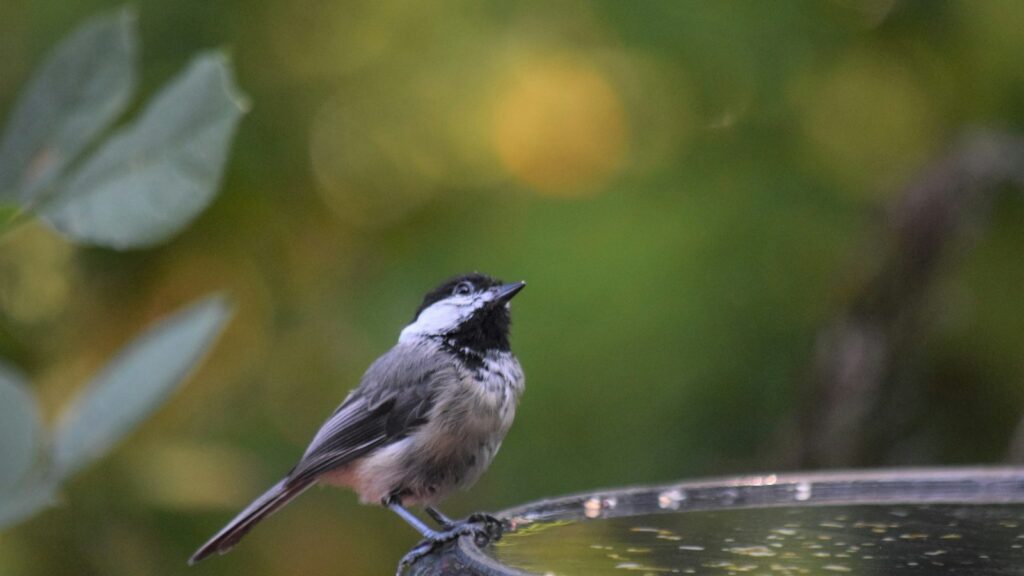
Chickadees embody a perfect blend of curiosity and caution, approaching new objects or food sources with a methodical inspection process. These small, energetic birds are often the first to discover and investigate new feeders in your yard, serving as scouts for other species. Their systematic approach is fascinating to watch – they’ll land nearby, assess the situation, dart in to grab a single seed, then retreat to a safe perch to eat or cache their prize. Chickadees possess remarkable spatial memory, remembering thousands of food storage locations throughout their territory. Their friendly, inquisitive nature makes them among the easiest birds to hand-feed, and their characteristic “chickadee-dee-dee” call varies in the number of “dee” notes to communicate different levels of threat to their flock members.
The Cautious Mourning Doves: Peaceful Grazers

Mourning Doves bring a gentle, peaceful presence to any backyard with their soft cooing and deliberate movements. These plump, tan-colored birds typically display cautious personalities, preferring to feed on the ground where they methodically pick through scattered seeds. Their careful nature is evident in how they approach feeders – often landing at a distance first, walking slowly closer, and startling easily at sudden movements. Despite their seemingly timid demeanor, Mourning Doves are remarkably resilient birds, raising multiple broods each season and flying with surprising speed when necessary, their wings making a distinctive whistling sound during take-off. They demonstrate strong pair bonds, with mated pairs often seen perching close together and engaging in gentle preening behaviors.
The Industrious Woodpeckers: Persistent Drummers

Woodpeckers bring a distinctive work ethic to your backyard, approaching their daily tasks with remarkable persistence and determination. These birds can be recognized not just by their appearance but by their methodical, purposeful drilling as they search for insects or create nesting cavities. Downy, Hairy, Red-bellied, and other woodpecker species demonstrate problem-solving intelligence when approaching suet feeders, often figuring out complex feeding stations faster than other birds. Their determined personalities are showcased in their willingness to spend hours hammering at trees, utility poles, or occasionally house siding, with some species delivering up to 12,000 pecks daily. Woodpeckers also exhibit territorial behaviors through drumming patterns that serve as acoustic advertisements of their presence, each species producing a slightly different rhythm that experienced observers can identify.
The Social Finches: Chatty Flock Members

House Finches and American Goldfinches bring a social, communal energy to your backyard with their tendency to feed in cheerful, vocal groups. These small, colorful birds typically arrive in numbers, creating a lively atmosphere with their continuous chirping and singing as they feed. Their social nature is evident in how they communicate constantly while feeding, with distinct calls indicating food sources or potential dangers to the group. Goldfinches in particular show an endearing playfulness, sometimes appearing to chase each other in aerial games between feeding sessions. During breeding season, you might observe males engaging in elaborate courtship displays, hovering with fluttering wings and singing complex songs to attract females, showcasing the important social dynamics within their communities.
The Skittish Sparrows: Nervous Nibblers

Various sparrow species that frequent backyards often display notably cautious, even nervous personalities as they approach feeding areas. These small, brown-streaked birds typically exhibit a pattern of darting quickly to feeders, grabbing a single seed, then retreating to safer cover to consume their find. Their vigilant nature is evident in their constant head movements, scanning for potential threats even while feeding. Song Sparrows, White-throated Sparrows, and their relatives often travel in loose groups, with individuals maintaining a distinct pecking order that careful observers can identify over time. Despite their seemingly anxious demeanor, sparrows demonstrate remarkable adaptability to human environments and subtle intelligence in their feeding strategies, often being among the first birds to discover scattered seed beneath feeders.
The Bold Hummingbirds: Feisty Defenders

Hummingbirds may be tiny, but their personalities are outsized, characterized by remarkable territoriality and fierce determination. These jewel-like birds establish and vigorously defend their feeding territories, with individuals often claiming ownership of specific feeders or flowering patches in your yard. You’ll observe them chasing away not just other hummingbirds but sometimes much larger birds that venture too close to their preferred nectar sources. Their bold personalities are displayed through elaborate aerial displays, with males performing impressive diving maneuvers that can reach speeds of 60 mph during courtship. Despite their aggressive territoriality, hummingbirds show surprising memory capabilities, remembering feeding locations from year to year and even recognizing humans who regularly fill their feeders.
The Opportunistic Robins: Ground Foragers
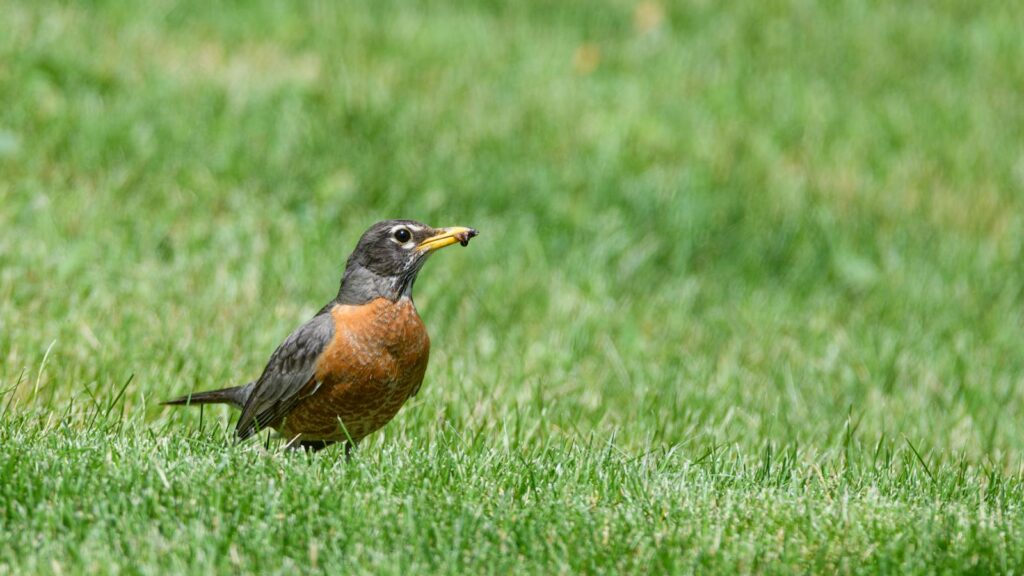
American Robins bring a distinctly opportunistic, adaptable personality to your yard as they hop purposefully across lawns in search of earthworms and insects. These familiar birds with rusty-orange breasts demonstrate remarkable patience as they cock their heads, seemingly listening for movement beneath the soil before striking precisely to capture prey. Their opportunistic nature is evident after rain showers, when they quickly take advantage of worms forced to the surface. Robins show seasonal personality shifts, appearing as solitary hunters in spring and summer, then transforming into social fruit-eaters in fall and winter when they gather in large flocks to strip berries from trees and shrubs. Their adaptability extends to nesting behaviors, with urban robins increasingly using man-made structures and showing less fear of human activity than their rural counterparts.
The Shy Thrushes: Secretive Songsters
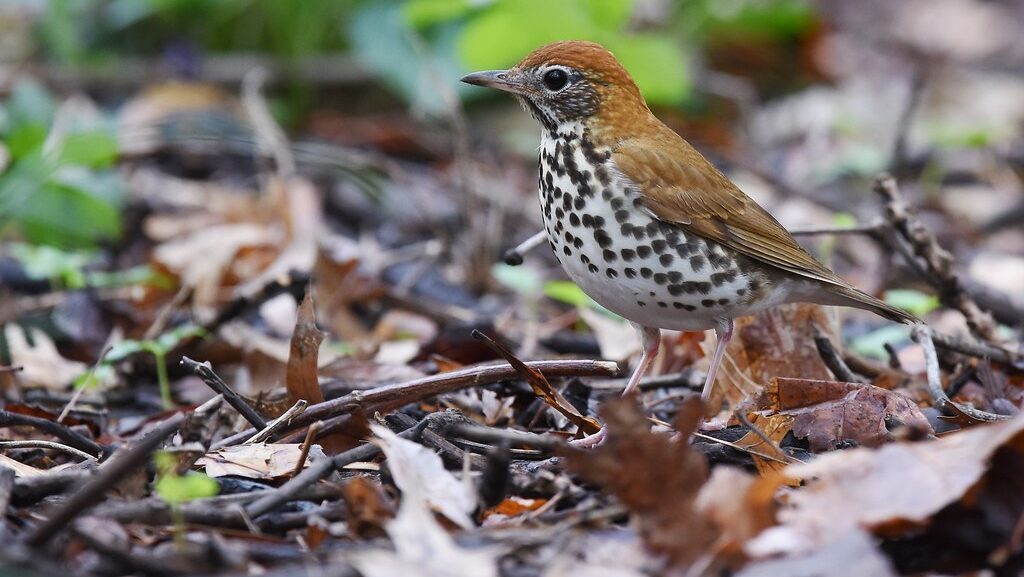
Hermit Thrushes, Wood Thrushes, and their relatives represent some of the more elusive personalities in your backyard bird community. These medium-sized, brown-backed birds with spotted breasts typically prefer the edges of yards near wooded areas, revealing their shy, cautious temperaments. Their secretive nature means you’ll often hear their hauntingly beautiful, flute-like songs long before catching a glimpse of the birds themselves. When observed, thrushes move with deliberate care, often freezing in place when they sense they’ve been spotted. Their methodical foraging behavior involves carefully turning over leaves on the ground in search of insects and small invertebrates, demonstrating patience and thoroughness in their feeding approach.
The Adaptable Starlings: Gregarious Mimics

European Starlings, despite being non-native birds with a sometimes negative reputation, display fascinatingly complex social personalities in backyard settings. These iridescent black birds are highly gregarious, often arriving in coordinated flocks that move with remarkable synchronization, creating shifting patterns in the sky known as murmurations. Their adaptable, opportunistic nature is evident in how quickly they exploit new food sources and nesting locations. Starlings showcase impressive vocal abilities, mimicking other birds, human sounds, and even mechanical noises with startling accuracy. Their persistent personalities are demonstrated through their determined feeding behaviors, where they systematically probe lawns with their specialized bills that open when inserted into the ground – a unique adaptation that allows them to access insects other birds cannot reach.
The Regal Raptors: Patient Hunters
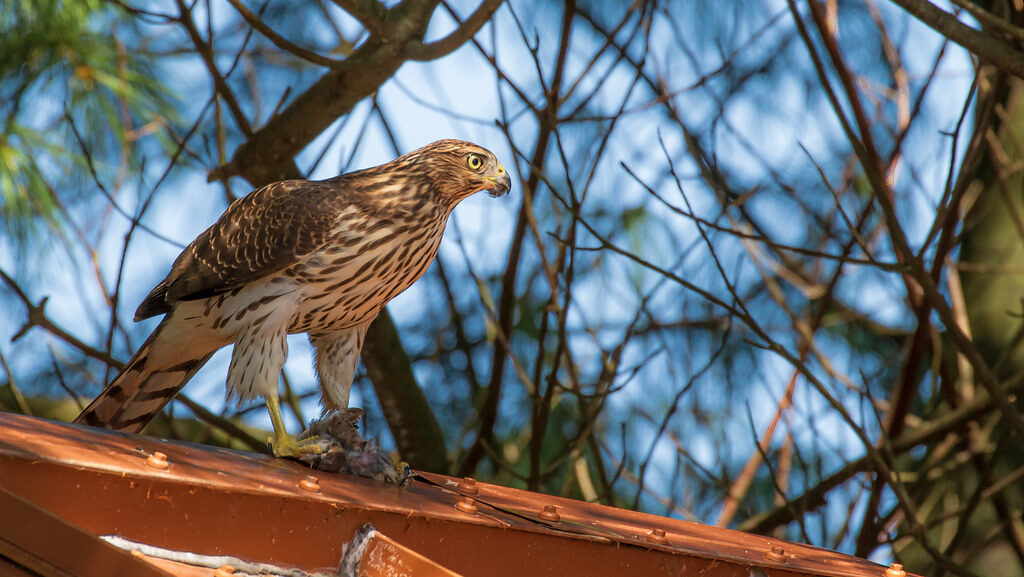
Hawk species like Cooper’s Hawks and Sharp-shinned Hawks occasionally bring a predatory presence to backyard bird communities, displaying patience and strategic thinking in their hunting approaches. These raptors reveal calculated personalities as they perch motionlessly for extended periods, waiting for the perfect moment to launch surprise attacks on smaller birds. Their hunting intelligence is evident in how they use landscape features to conceal their approach, sometimes flying low around buildings to ambush feeding birds. Cooper’s Hawks in particular have adapted increasingly to suburban environments, learning to exploit the concentrated food sources that bird feeders create. While their presence may temporarily disperse your regular feathered visitors, these impressive predators play important ecological roles and provide fascinating glimpses into the complete backyard ecosystem.
Interpreting Bird Behavior: Reading Personality Clues

Understanding bird personalities goes beyond identifying patterns specific to each species – it requires observing subtle behavioral cues that indicate individual moods and intentions. Posture offers significant insights, with fluffed feathers generally signaling relaxation while sleeked-down feathers often indicate alarm or aggression. Vocalizations vary not just between species but within individuals, with changes in call volume, frequency, and pattern revealing different emotional states or responses to environmental changes. Wing and tail movements provide additional personality indicators – rapid tail flicking in many species signals agitation, while drooped wings might indicate submission or illness. Regular observation will help you develop a nuanced understanding of your backyard birds’ behavioral language, allowing you to recognize individual personality variations even within the same species.
Creating a Personality-Friendly Yard

Designing your outdoor space to accommodate diverse bird personalities enhances both their well-being and your observation opportunities. Shy species benefit from dense shrubs and evergreens that provide security while allowing them to access feeding areas. Ground-feeding personalities like sparrows and doves appreciate scattered seeds beneath elevated feeders where more confident species like cardinals and jays prefer to dine. Consider positioning multiple feeding stations at varying heights and distances from cover to reduce competition and allow different personality types to feed comfortably according to their confidence levels. Water features with varying depths accommodate different bathing preferences, from cautious sippers at shallow edges to enthusiastic splashers in deeper sections. By creating microhabitats that cater to different comfort levels, you’ll attract and retain a more diverse community of feathered personalities in your yard.
Conclusion

Recognizing the distinct personalities of backyard birds transforms casual bird watching into a deeper connection with the natural world. Each feathered visitor brings not just beauty but a unique character to your outdoor space – from the bold assertiveness of blue jays to the methodical curiosity of chickadees. As you become familiar with these avian personalities, you’ll develop a richer understanding of the complex social dynamics unfolding just beyond your window. This awareness fosters a sense of stewardship and respect for the remarkable diversity of bird life that shares our immediate environment. By observing and appreciating these distinctive personalities, we gain not just knowledge about different species but a meaningful window into the intricate, beautiful world of birds that enriches our daily lives.
